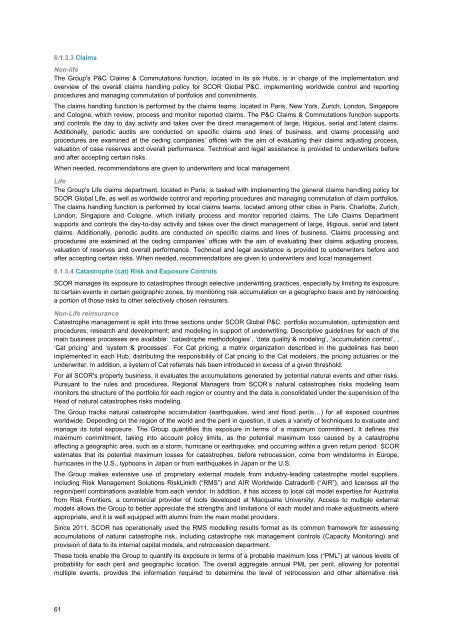4.4 Legal risk - Scor
4.4 Legal risk - Scor
4.4 Legal risk - Scor
Create successful ePaper yourself
Turn your PDF publications into a flip-book with our unique Google optimized e-Paper software.
6.1.3.3 Claims<br />
Non-life<br />
The Group's P&C Claims & Commutations function, located in its six Hubs, is in charge of the implementation and<br />
overview of the overall claims handling policy for SCOR Global P&C, implementing worldwide control and reporting<br />
procedures and managing commutation of portfolios and commitments.<br />
The claims handling function is performed by the claims teams, located in Paris, New York, Zurich, London, Singapore<br />
and Cologne, which review, process and monitor reported claims. The P&C Claims & Commutations function supports<br />
and controls the day to day activity and takes over the direct management of large, litigious, serial and latent claims.<br />
Additionally, periodic audits are conducted on specific claims and lines of business, and claims processing and<br />
procedures are examined at the ceding companies’ offices with the aim of evaluating their claims adjusting process,<br />
valuation of case reserves and overall performance. Technical and legal assistance is provided to underwriters before<br />
and after accepting certain <strong>risk</strong>s.<br />
When needed, recommendations are given to underwriters and local management.<br />
Life<br />
The Group's Life claims department, located in Paris, is tasked with implementing the general claims handling policy for<br />
SCOR Global Life, as well as worldwide control and reporting procedures and managing commutation of claim portfolios.<br />
The claims handling function is performed by local claims teams, located among other cities in Paris, Charlotte, Zurich,<br />
London, Singapore and Cologne, which initially process and monitor reported claims. The Life Claims Department<br />
supports and controls the day-to-day activity and takes over the direct management of large, litigious, serial and latent<br />
claims. Additionally, periodic audits are conducted on specific claims and lines of business. Claims processing and<br />
procedures are examined at the ceding companies’ offices with the aim of evaluating their claims adjusting process,<br />
valuation of reserves and overall performance. Technical and legal assistance is provided to underwriters before and<br />
after accepting certain <strong>risk</strong>s. When needed, recommendations are given to underwriters and local management.<br />
6.1.3.4 Catastrophe (cat) Risk and Exposure Controls<br />
SCOR manages its exposure to catastrophes through selective underwriting practices, especially by limiting its exposure<br />
to certain events in certain geographic zones, by monitoring <strong>risk</strong> accumulation on a geographic basis and by retroceding<br />
a portion of those <strong>risk</strong>s to other selectively chosen reinsurers.<br />
Non-Life reinsurance<br />
Catastrophe management is split into three sections under SCOR Global P&C: portfolio accumulation, optimization and<br />
procedures; research and development; and modeling in support of underwriting. Descriptive guidelines for each of the<br />
main business processes are available: ‘catastrophe methodologies’, ‘data quality & modeling’, ‘accumulation control’, ,<br />
‘Cat pricing’ and ‘system & processes’. For Cat pricing, a matrix organization described in the guidelines has been<br />
implemented in each Hub, distributing the responsibility of Cat pricing to the Cat modelers, the pricing actuaries or the<br />
underwriter. In addition, a system of Cat referrals has been introduced in excess of a given threshold.<br />
For all SCOR's property business, it evaluates the accumulations generated by potential natural events and other <strong>risk</strong>s.<br />
Pursuant to the rules and procedures, Regional Managers from SCOR’s natural catastrophes <strong>risk</strong>s modeling team<br />
monitors the structure of the portfolio for each region or country and the data is consolidated under the supervision of the<br />
Head of natural catastrophes <strong>risk</strong>s modeling.<br />
The Group tracks natural catastrophe accumulation (earthquakes, wind and flood perils…) for all exposed countries<br />
worldwide. Depending on the region of the world and the peril in question, it uses a variety of techniques to evaluate and<br />
manage its total exposure. The Group quantifies this exposure in terms of a maximum commitment. It defines this<br />
maximum commitment, taking into account policy limits, as the potential maximum loss caused by a catastrophe<br />
affecting a geographic area, such as a storm, hurricane or earthquake, and occurring within a given return period. SCOR<br />
estimates that its potential maximum losses for catastrophes, before retrocession, come from windstorms in Europe,<br />
hurricanes in the U.S., typhoons in Japan or from earthquakes in Japan or the U.S.<br />
The Group makes extensive use of proprietary external models from industry-leading catastrophe model suppliers,<br />
including Risk Management Solutions RiskLink® (“RMS”) and AIR Worldwide Catrader® (“AIR”), and licenses all the<br />
region/peril combinations available from each vendor. In addition, it has access to local cat model expertise for Australia<br />
from Risk Frontiers, a commercial provider of tools developed at Macquarie University. Access to multiple external<br />
models allows the Group to better appreciate the strengths and limitations of each model and make adjustments where<br />
appropriate, and it is well equipped with alumni from the main model providers.<br />
Since 2011, SCOR has operationally used the RMS modelling results format as its common framework for assessing<br />
accumulations of natural catastrophe <strong>risk</strong>, including catastrophe <strong>risk</strong> management controls (Capacity Monitoring) and<br />
provision of data to its internal capital models, and retrocession department.<br />
These tools enable the Group to quantify its exposure in terms of a probable maximum loss (“PML”) at various levels of<br />
probability for each peril and geographic location. The overall aggregate annual PML per peril, allowing for potential<br />
multiple events, provides the information required to determine the level of retrocession and other alternative <strong>risk</strong><br />
61
















